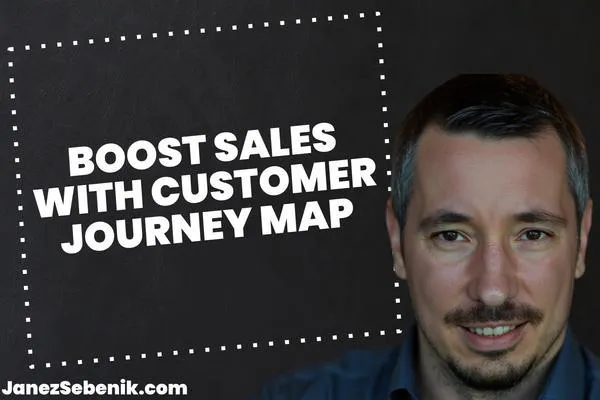
What are the 5 key components of a customer journey map?
Want to boost your business? A customer journey map is your secret weapon. It shows you exactly how customers interact with your brand, from start to finish.
The 5 key components of a customer journey map are the actor, timeline, touchpoints, emotions, and opportunities. These elements help you see your business through your customers' eyes.
By mapping out the customer journey, you can spot problems and fix them fast. You'll know what makes your customers happy, sad, or frustrated. This knowledge is pure gold for improving your products and services.
Key Takeaways
Customer journey maps reveal how people experience your brand
They help you identify and fix pain points in the customer experience
Using journey maps can boost customer satisfaction and loyalty
Breaking Down the Customer Journey Map
A customer journey map shows how people interact with your business. It helps you see things from their point of view and find ways to make their experience better.
Understanding the Concept
Think of a customer journey map like a road trip. You're the customer, and your business is the destination. The map shows all the stops along the way.
It's not just about the end goal. It's about every little thing that happens on the journey. Every phone call, every click, every conversation.
This visual representation helps you see the big picture. You can spot where things go smoothly and where they get bumpy.
Key Components Unveiled
Now, let's break it down. Your map needs five key ingredients:
Personas: These are like characters in a story. Who are your customers? What do they want?
Timeline: This is the when. From the first time they hear about you to long after they've bought something.
Touchpoints: These are all the places customers interact with you. Your website, your store, your ads.
Emotions: How do customers feel at each step? Happy? Frustrated? Confused?
Pain Points: Where do things go wrong? What makes customers want to give up?
By spotting these issues, you can fix them. Turn those frowns upside down. Make the journey smooth and enjoyable.
Cracking Customer Personas
Customer personas are like your business's secret weapon. They help you understand your customers better than they understand themselves. Let's dive into how to create and use these powerful tools.
Crafting the Persona
You start by gathering demographic data. Age, income, job title - that's the easy stuff. But don't stop there. Dig deeper. What keeps your customers up at night? What are their dreams?
Think about their goals. Are they trying to get a promotion? Save time? Look cool in front of their friends? These insights are gold.
Don't forget about mindsets. Is your customer always in a rush? Are they a perfectionist? A bargain hunter? This info shapes how you talk to them.
Lastly, give your persona a name and face. It makes them feel real. "Budget Bob" or "Luxury Lisa" - make it stick.
Applying Personas to the Journey
Now that you've got your personas, it's time to put them to work. Map out how they interact with your business. Where do they first hear about you? What questions do they ask?
Think about their pain points. Where do they get stuck? What frustrates them? This is where you can swoop in and be the hero.
Use your personas to create a personalized experience. Tailor your marketing, your product, even your customer service. Make them feel like you're reading their mind.
Remember, personas aren't set in stone. Keep refining them as you learn more. The better you know your customers, the more money you'll make. It's that simple.
Touchpoints and Interactions
Touchpoints make or break your customer's journey. They're where the magic happens - or where it all falls apart. Let's dive into how to nail these crucial moments.
Identifying Key Touchpoints
You gotta know where your customers are bumping into your brand. It's like a game of connect-the-dots, but way more fun (and profitable).
Start by mapping out the whole customer journey. From the moment they realize they've got a problem to the happy dance they do after buying your solution.
Look for every spot they interact with you. Social media? Yep. Your website? You bet. That awkward chat with your sales guy? Absolutely.
Don't forget the less obvious touchpoints. Like when they're googling reviews about you at 2 AM. Or when they're complaining to their friend about your confusing return policy.
Optimizing the Touchpoints
Now that you've spotted your touchpoints, it's time to make 'em shine. Think of each one as a chance to wow your customer.
First up, consistency is key. Your brand voice should be the same whether they're reading your Instagram caption or chatting with customer service.
Next, make it personal. Use their name, remember their preferences. It's like being a mind reader, but less creepy and more profitable.
Smooth out any friction. Is your checkout process a nightmare? Fix it. Are your emails going to spam? Solve it.
Finally, ask for feedback. Then actually use it. Your customers are telling you how to take their money. Listen up!
Emotional Journey and Pain Points
Customers feel stuff when they interact with your brand. Good and bad. It's your job to figure out what those feelings are and fix the crappy parts.
Mapping the Emotional Curve
You gotta track how your customers feel at each step. Happy? Frustrated? Confused? Make a chart.
Start with their first contact. Maybe they're excited about your product. Awesome.
But then they hit your website. It's a mess. Now they're annoyed. Not good.
Map out these emotional ups and downs. It'll show you where you're killing it and where you're dropping the ball.
Use surveys, reviews, and social media to get the real scoop. Don't guess.
Addressing the Pain Points
Now for the fun part. Find the spots where your customers want to punch a wall.
Maybe your checkout process is a nightmare. Or your customer service makes people cry.
These are your pain points. They're costing you money and loyal fans.
Identify these friction points. Then fix 'em. Fast.
Turn those frowns upside down. Make the experience smooth as butter.
Remember, happy customers stick around. And they tell their friends. That's money in the bank for you.
Leveraging Opportunities and Insights
Customer journey maps reveal gold mines of info about your customers. Use this data to boost your business and give customers what they really want.
Extracting Actionable Insights
Look at your map like a treasure hunt. Where are customers getting stuck? What's making them happy?
Use quantitative data to back up what you see. Numbers don't lie. They'll show you exactly where to focus.
Pay attention to customer behavior. Are they bouncing off certain pages? Loving a specific feature? That's valuable intel.
Market trends matter too. What's hot right now? How does it fit with what your customers want? Stay ahead of the curve.
Capitalizing on Opportunities
Now it's time to make moves. Use your insights to create kick-ass marketing strategies.
Tailor your message to hit customer needs at each stage. Make them feel like you're reading their minds.
Get your sales team on board. They're on the front lines. Give them the ammo they need to close deals.
Smooth out your customer onboarding. First impressions count. Make it so easy, a toddler could do it.
Remember, your customer journey map is a living document. Keep updating it as you learn more. The more you use it, the more value you'll get.
Action Plan and Measurement
You've mapped the journey. Now it's time to turn insights into action and track your progress. Let's dive into how to make your customer journey map work for you.
Developing a Strategic Action Plan
First up, grab that customer journey map template. Circle the pain points. These are your goldmines.
For each pain point, brainstorm solutions. Think big. What would blow your customer's mind?
Now, prioritize. Which fixes will make the biggest impact? Start there.
Break down each solution into actionable steps. Assign owners and deadlines. Be specific.
Don't forget your marketing automation tools. Use them to smooth out the bumps in the journey.
Remember, this isn't just for B2C. B2B folks, you need this too. Your customer lifecycle might be longer, but the principles are the same.
Measuring Success
Time to keep score. Set up metrics for each stage of the journey.
Start with the basics: conversion rates and Net Promoter Score. These metrics give you a quick health check.
But don't stop there. Dig deeper. How's the purchase experience? Are customers coming back?
Use your project management tools to track progress on your action items. Set up regular check-ins.
Keep your eye on the prize. Are you moving the needle on customer satisfaction? That's the real win.
Remember, this isn't a one-and-done deal. Keep tweaking, keep measuring. Your customer journey map is a living document. Let it evolve as your business grows.
